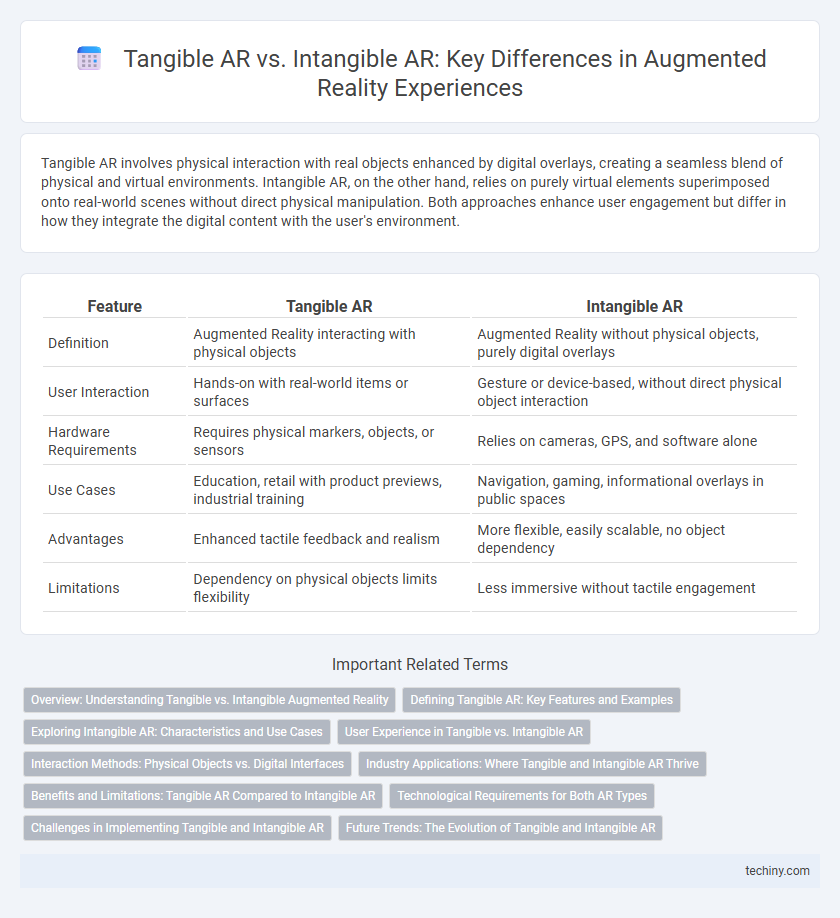Tangible AR involves physical interaction with real objects enhanced by digital overlays, creating a seamless blend of physical and virtual environments. Intangible AR, on the other hand, relies on purely virtual elements superimposed onto real-world scenes without direct physical manipulation. Both approaches enhance user engagement but differ in how they integrate the digital content with the user's environment.
Table of Comparison
| Feature | Tangible AR | Intangible AR |
|---|---|---|
| Definition | Augmented Reality interacting with physical objects | Augmented Reality without physical objects, purely digital overlays |
| User Interaction | Hands-on with real-world items or surfaces | Gesture or device-based, without direct physical object interaction |
| Hardware Requirements | Requires physical markers, objects, or sensors | Relies on cameras, GPS, and software alone |
| Use Cases | Education, retail with product previews, industrial training | Navigation, gaming, informational overlays in public spaces |
| Advantages | Enhanced tactile feedback and realism | More flexible, easily scalable, no object dependency |
| Limitations | Dependency on physical objects limits flexibility | Less immersive without tactile engagement |
Overview: Understanding Tangible vs. Intangible Augmented Reality
Tangible augmented reality integrates physical objects with digital content, allowing users to interact with virtual elements through real-world touchpoints, enhancing spatial awareness and user engagement. Intangible augmented reality, by contrast, overlays virtual information without physical interaction, relying on visual or auditory cues to enrich the environment without direct tactile feedback. This distinction influences application design across industries, from immersive retail experiences to hands-free data visualization in medical and industrial settings.
Defining Tangible AR: Key Features and Examples
Tangible Augmented Reality (AR) integrates physical objects with digital content, enabling users to interact with virtual elements through touch and manipulation of real-world items. Key features include sensor-based tracking, haptic feedback, and spatial mapping, which create immersive and interactive experiences in education, gaming, and industrial training. Examples of tangible AR applications are Microsoft HoloLens for hands-on assembly guidance and tangible tabletop interfaces used in collaborative design environments.
Exploring Intangible AR: Characteristics and Use Cases
Intangible augmented reality (AR) emphasizes overlaying virtual content without physical objects, enhancing user interaction through sensory inputs like sound, gestures, or spatial mapping. Key use cases include virtual meetings, immersive training simulations, and remote assistance where real-world objects are not required, allowing greater flexibility and scalability. This form of AR leverages environmental understanding and user context to create seamless, interactive experiences in healthcare, education, and entertainment industries.
User Experience in Tangible vs. Intangible AR
Tangible AR enhances user experience by integrating physical objects with digital content, enabling intuitive interaction through touch and manipulation, which fosters deeper immersion and engagement. Intangible AR relies on visual and auditory stimuli without physical contact, often leading to a more passive but flexible user experience suitable for diverse environments. The contrast in user experience between tangible and intangible AR lies in the degree of sensory involvement and the immediacy of feedback, affecting usability and cognitive load.
Interaction Methods: Physical Objects vs. Digital Interfaces
Tangible augmented reality relies on physical objects as interaction methods, allowing users to manipulate real-world items embedded with digital information for a more immersive experience. Intangible AR employs digital interfaces such as touchscreens, gesture recognition, or voice commands to interact with virtual elements, offering greater flexibility and accessibility without the need for physical props. Both approaches enhance user engagement but differ in sensory feedback and context-dependent applicability.
Industry Applications: Where Tangible and Intangible AR Thrive
Tangible AR excels in industrial applications such as manufacturing, where physical interaction with augmented tools enhances precision and efficiency in assembly lines and maintenance tasks. Intangible AR finds its strength in sectors like healthcare and education, providing immersive simulations and data overlays without the need for physical objects, improving training and patient care. Both types of AR drive innovation, with tangible AR optimizing hands-on tasks and intangible AR revolutionizing information accessibility and situational awareness.
Benefits and Limitations: Tangible AR Compared to Intangible AR
Tangible AR offers enhanced user engagement through physical interaction, improving spatial understanding and memory retention by linking virtual content to real-world objects. Its limitations include higher development costs and reduced flexibility compared to intangible AR, which excels in accessibility and ease of content updates without physical constraints. Intangible AR benefits from seamless integration with mobile devices but may lack the immersive depth and tactile feedback that tangible AR provides.
Technological Requirements for Both AR Types
Tangible Augmented Reality requires advanced hardware including sensors, cameras, and haptic feedback devices to enable physical interaction and accurate spatial mapping. Intangible Augmented Reality primarily depends on robust software algorithms, cloud computing, and real-time data processing to overlay virtual elements seamlessly without physical touchpoints. Both AR types demand high-performance processors and low-latency networks to ensure smooth and immersive user experiences.
Challenges in Implementing Tangible and Intangible AR
Implementing tangible AR faces challenges in creating accurate physical-digital interaction, requiring precise tracking and durable hardware that can withstand real-world use. Intangible AR struggles with seamless integration into everyday environments due to limited sensory feedback and reliance on device-dependent interfaces. Both forms must overcome latency issues and environmental variability to ensure stable, immersive augmented experiences.
Future Trends: The Evolution of Tangible and Intangible AR
Future trends in augmented reality indicate a seamless integration between tangible AR, which utilizes physical objects to anchor digital content, and intangible AR, relying solely on environmental sensing and spatial mapping for immersive experiences. Advances in AI-driven interaction and 5G connectivity will enhance real-time responsiveness and precision, pushing tangible and intangible AR towards hybrid solutions that blend physical and virtual realms effortlessly. The evolution of these AR forms will drive innovations in sectors like healthcare, education, and retail, delivering personalized and context-aware experiences.
tangible AR vs intangible AR Infographic

 techiny.com
techiny.com